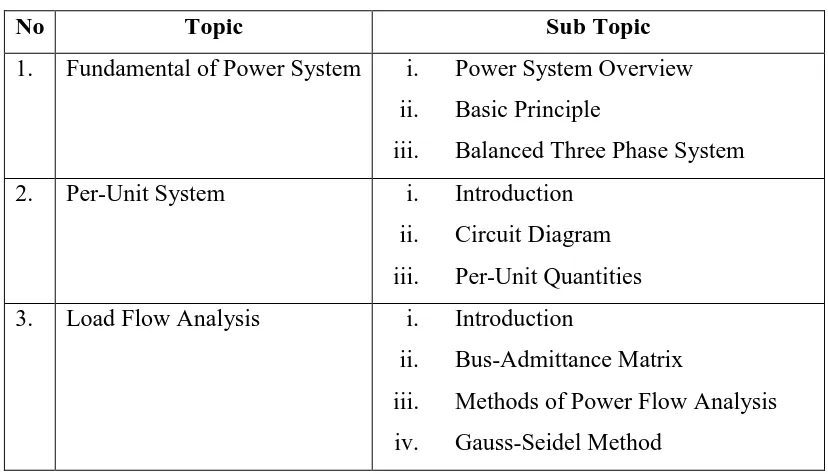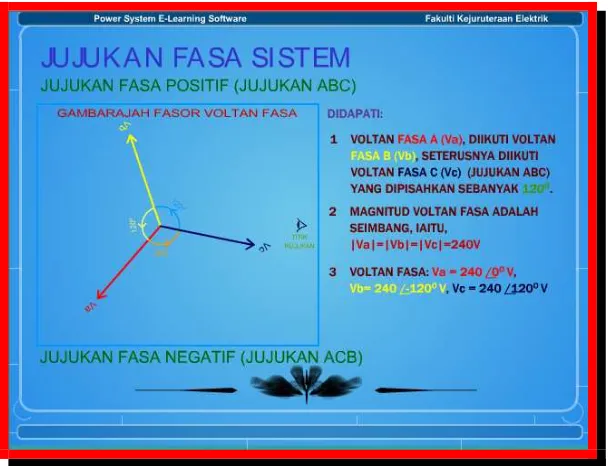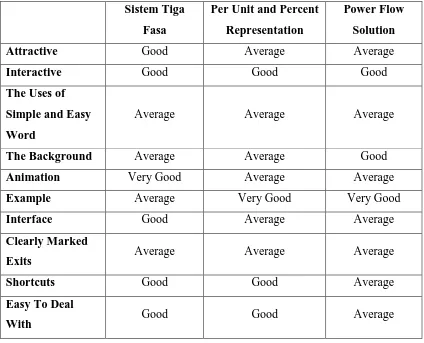BASIC POWER SYSTEM FUN LEARNING
NORHALILA BINTI SAMSOL
A report submitted in partial fulfillment of the requirements for the degree of Electrical Engineering
Faculty of Electrical Engineering
UNIVERSITI TEKNIKAL MALAYSIA MELAKA
“I hereby declare that I have read through this report entitle Basic Power System Fun Learning and found that it has comply the partial fulfillment for awarding the degree
of Bachelor of Electrical Engineering (Industrial Power)”
Signature :
Supervisor’s Name : Pn. Jurifa bt Mat Lazi
iv
To my beloved father and my late mother, En. Samsol Bin Selamat and Rosidah Binti Abdullah
To my sisters,
v
ACKNOWLEDGEMENT
First and foremost I would like to express my deepest gratitude to Allah S.W.T for His guidance and blessing throughout this final year project. I would also like to thank my supervisor Pn. Jurifa bt Mat Lazi for her advices, encouragement, guidance critics, motivation, friendship, insight and willingness dealing with me to help completing this project.
I am also thankful to my helpful Engineering Ethic’s tutor, Mr. Farhan bin Hanaffi, from Faculty of Electrical Engineering, who really helpful in giving his ideas and comment to improve my project. For my family, thank for your support neither in moral nor money from the beginning till the end of this project. Without their continued support, pray, help and interest, this project would not have been same as presented here.
My sincere appreciation also extends to all my colleagues and others who have provided assistance at various occasions. Their views and tips are useful indeed. Unfortunately, it is not possible to list all of them in this limited space.
vi
ABSTRACT
vii
ABSTRAK
viii
TABLE OF CONTENTS
CHAPTER TITLE PAGE
AKNOWLEDGMENT v
ABSTRACT vi
TABLE OF CONTENTS viii
LIST OF TABLES xi
LIST OF FIGURES xii
NOMENCLATURE xiv
LIST OF APPENDICES xv
1 INTRODUCTION 1
1.1 Project Background 1
1.2 Problem Statement 2
1.3 Project Objectives 3
1.4 Project Scope 3
2 LITERATIRE REVIEW 5
2.1 Introduction 5
2.2 Domain 5
2.3 Existing System 6
2.3.1 Comparison of Existing System 9 2.4 Outline of E-Learning Module 10
2.4.1 Macromedia Flash Professional 8 Software 11 2.4.4.1Interface Elements 11 2.4.2 Fundamental of Power System 12
2.4.3 Per-Unit System 13
ix
2.5 Conclusion 14
3 PROJECT METHODOLOGY 15
3.1 Introduction 15
3.2 Project Methodology 15
3.2.1 Interaction Design 17
3.2.2 Flow Chart 18
3.3 Template Design 20
3.4 Project Requirements 22
3.5 Conclusion 23
4 SOFTWARE DEVELOPMENT 24
4.1 Introduction 24
4.2 Starting with Microsoft Office Word 2007 Software 24 4.2.1 Stage 1: Learning Design and Storyboard 24 4.3 Continue with Macromedia Flash 8 Software 25 4.3.1 Stage 2: Front Page and Menu Page Design 25 4.3.2 Stage 3: Background and Graphic Design 26 4.3.3 Stage 4: Animation Design 27 4.3.4 Stage 5: Funftional Button 27 4.3.5 Stage 6: Action Script 28 4.3.6 Stage 7: Software Testing 29
4.4 Conclusion 29
5 RESULT AND DISCUSSION 30
5.1 Introduction 30
5.2 Result 30
5.2.1 Front Page 31
5.2.2 Fundamental of Power System 31 5.2.2.1Power System Overview 32 5.2.2.2Basic Principle 34 5.2.2.3Balanced Three Phase System 36
x
5.2.3.1Introduction 39
5.2.3.2Circuit Diagram 39 5.2.3.3Per-Unit Quantities 40
5.2.4 Load Flow Analysis 40
5.2.4.1Introduction 41
5.2.4.2Bus Admittance Matrix 41 5.2.4.3Method of Power Flow Analysis 43 5.2.4.4Gauss-Seidel Method 43
5.3 User Feedback 44
5.3.1 Test Plan 44
5.3.2 Test User 44
5.3.3 Test Implementation 45
5.3.3.1Test Data 45
5.3.3.2Test Result and Analysis 45
5.4 Discussion 50
6 CONCLUSION 51
6.1 Conclusion 51
6.2 Recommendation 52
REFERENCE 53
xi
LIST OF TABLES
TABLE TITLE PAGE
1.1 Project Scope 4
2.1 Comparison of Existing System by using Heuristic Evaluation 10
5.1 Number of Test User 45
5.2 Result for Statement 1 46
5.3 Result for Statement 2 47
5.4 Result for Statement 3 48
xii
LIST OF FIGURE
FIGURE TITLE PAGE
2.1 Learning content of ‘Sistem Tiga Fasa’ 7 2.2 Learning content of ‘Per-Unit and Percent Representation’ 8 2.3 Learning content of ‘Power Flow Solution’ 9 2.4 Macromedia Flash Professional 8 Interface Elements 12
2.5 Power System 13
3.1 The ADDIE Learning Design Cycle 16
3.2 The Interaction Design Cycle 18
3.3 Flow Chart to guide on developing Basic Power System Fun
Learning 19
3.4 Flow Chart of Educational Website for Basic Power System
Fun Learning 20
3.5 Example of main page for template design 21 3.6 Example of menu page for template design 21 3.7 Example of activity page for template design 22
4.1 Front page of Basic 25
4.2 Main Menu Page 26
4.3 Graphic Design 27
4.4 Animation Design 27
4.5 Home Button 28
4.6 Action Script for Button 28
4.7 Software development flowchart 29
xiii
5.5 Electricity Process sub-subtopic 33
5.6 Value indicator sub-subtopic 34
5.7 RLC element sub-subtopic 34
5.8 Power sub-subtopic 35
5.9 Exercise of Instantaneous Power sub-subtopic 36
5.10 Balanced Source sub-subtopic 37
5.11 Delta to Star Transformation sub-subtopic 37 5.12 Activity for Balanced Three-Phase System sub-subtopic 38
5.13 Per Unit System subtopic 38
5.14 Advantages sub-subtopic 39
5.15 Symbol sub-subtopic 39
5.16 Per-Unit sub-subtopic 40
5.17 Load Flow Analysis subtopic 41
5.18 Introduction of Load Flow Analysis sub-subtopic 41
5.19 Impedance Diagram sub-subtopic 42
5.20 Bus Impedance versus Bus Admittance sub-subtopic 42 5.21 Methods of Power Flow Analysis sub-subtopic 43
5.22 Power Flow Solution sub-subtopic 43
5.23 Column chart for Statement 1 46
5.24 Column chart for Statement 2 47
5.25 Column chart for Statement 3 48
xiv
NOMENCLATURE
AC - Alternating Current BTN - Button
DC - Direct Current
FKE - Faculty of Electrical Engineering FYP - Final Year Project
ODL - open and distance learning
pu - Per-Unit
RLC - resistor, inductor and capacitor rms - Root Mean Square
xv
LIST OF APPENDICES
APPENDIX TITLE PAGE
CHAPTER 1
INTRODUCTION
1.1 Project Background
Basic Power System Fun Learning is a project that used an e-Learning approach. E-learning or also known as Electronic Learning is a type of technology supported education or learning where the medium of instruction is through computer technology. E-Learning can also defined as a network or online that takes place in a formal context and uses a range of multimedia technologies. The learning process can be carried out either individually or on small or large group basis. Since this learning process is using computer technology, for some instances there is no face-to-face interaction takes place for example it is exclusively used in open and distance learning (ODL). However, it also can be used in conjunction with face to face teaching. As such, e-Learning is not confined to the boundaries of the online format but also includes the offline format using any form of electronic media to facilitate the teaching and learning process. Users have the ability to work on the course at any time and from anywhere as long as there is a computer, internet access and a board email account if needed. E-Learning furnishes user with the self-paced modules, knowledge of the internet and computer skills, an opportunity to become independent and self reliant, flexibility of time-tabling and scheduling.
2
by online networking fits with the idea that students should take greater responsibility for their own learning.
The Basic Power System Fun Learning is an e-Learning lesson on Basic Power System subject. Three chapters are involved which is Fundamental of Power System, Per Unit System and Load Flow Analysis. The aim is to make the study about Basic Power System subject interesting, simple and easy. The project is designed to guide students in Faculty of Electrical Engineering (FKE), Universiti Teknikal Malaysia Melaka (UTeM) especially second year students through information in an easy way with animations to make it easy to be understood. Hence, this project is profitable and helpful in education process since it can increase consistency among student when learning is captured and delivered by technology.
1.2 Problem Statement
Problem statement is a clear concise description of the issues that faced during developing this project. The problem statement needs to be addressed by problem solving so that a good result can be achieved.
Currently e-Learning has not rapidly advanced in nowadays technology. Most of students are not exposed to this kind of learning process caused less understand to the environment. As such, students are not comfortable with e-Learning method, as they are more familiar with the traditional learning process. Since the implementation of e-learning system by any institution or this institution not extensive, the exposure to students about this learning environment is limited. Owing to as such, students cannot fully understand the benefit of the e-Learning education system. Indeed, this project might help to solve this problem by exposing to students an interactive e-Learning on Basic Power System subject.
3
education needs a total commitment and support from top management. Besides, the participation, cooperation and support from major universities are needed to expose the e-Learning to higher education. The Ministry of Education needs to have guidelines to help schools and higher learning institutions to implement e-Learning successfully and efficiently.
The manual learning process which is in classroom is less encourages most of students in understanding the subject of Basic Power System (Fundamental of Power System, Per-Unit System and Load Flow Analysis). Most of them have difficulties to clearly understand about this topic. Concern to this problem, Basic Power System Fun Learning is constructed to make the study about Basic Power System (Fundamental of Power System, Per-Unit System and Load Flow Analysis) simple and easy besides to convince the students to use this kind of learning system.
1.3 Project Objectives
In order to make sure this project perfectly complete, this project was developed based on several objectives. The objectives of this project are as below:
1. To develop an e-learning courseware on Basic Power System subject (Fundamental of Power System, Per-Unit System and Load Flow Analysis). 2. To study and explain the Basic Power System subject in creative way.
3. To expose an interactive way in study on Basic Power System (Fundamental of Power System, Per-Unit System and Load Flow Analysis) to electrical student.
1.4 Project Scope
4
Table 1.1: Project Scope
No Topic Sub Topic
1. Fundamental of Power System i. Power System Overview ii. Basic Principle
iii. Balanced Three Phase System 2. Per-Unit System i. Introduction
ii. Circuit Diagram iii. Per-Unit Quantities 3. Load Flow Analysis i. Introduction
ii. Bus-Admittance Matrix
CHAPTER 2
LITERATURE REVIEW
2.1Introduction
A literature review is a body of text that aims to review the critical points of current knowledge on a particular topic. A literature review can be just a simple summary of the sources, but it usually has an organizational pattern and combines both summary and synthesis. A summary is a recap of the important information of the source, but a synthesis is a re-organization, or a reshuffling, of that information. It might give a new interpretation of old material or combine new with old interpretations. It also might trace the intellectual progression of the field, including major debates.
The literature review ultimate goal is to bring the reader up to date with current literature on a topic and forms the basis for another goal, such as the justification for future research in the area. In this chapter, all the procedure of based system will be explained. This includes the domain that related to this web-based system, the current system that exists and the result after some research and comparison.
2.2Domain
6
software created by Macromedia and currently developed and distributed by Adobe Systems. Since its introduction in 1996, Flash has become a popular method for adding animation and interactivity to web pages; Flash is commonly used to create animation, advertisements, and various web page components, to integrate video into web pages, and more recently, to develop rich Internet applications. Flash can manipulate vector and raster graphics and supports bi-directional streaming of audio and video. It contains a scripting language called Action Script. Several software products, systems, and devices are able to create or display Flash content, including Adobe Flash Player, which is available for most common web browsers, some mobile phones and other electronic devices (using Flash Lite). The Adobe Flash Professional multimedia authoring program is used to create content for the Adobe Engagement Platform, such as web applications, games and movies, and content for mobile phones and other embedded devices.
This software will make the learning through e-learning interactive and attractive by sound effects (musical), audio instructions (linguistic), simple example with animation, and the tutorial about the topic.
2.3Existing System
The research on existing examples which related to this project is a must. It should be a good guideline or references as the case study on the existing system will be constructed in finding the advantages and disadvantages in order to accomplished this project successfully.
i) Example 1: E-learning on ‘Sistem Tiga Fasa’ (Three Phase System)
7
through this page, user can simply understand and gain knowledge. However, this e-Learning provides no example. Overall, this ‘Sistem Tiga Fasa’ e-Learning example is interactive and attractive.
Figure 2.1: Learning content of ‘Sistem Tiga Fasa’
ii) Example 2: E-learning on ‘Per Unit and Percent Representation’
8
Figure 2.2: Learning content of ‘Per-Unit and Percent Representation’
iii) Example 3: E-learning on ‘Power Flow Solution’
9
Figure 2.3: Learning content of ‘Power Flow Solution’
2.3.1 Comparison of Existing System
The e-Learning lesson examples of ‘Sistem Tiga Fasa’ and ‘Power Flow Solution’ are attractive, whereas, an e-Learning lesson example of ‘Per Unit and Percent Representation’ is not so attractive. The e-Learning lesson example on ‘Sistem Tiga Fasa’ developed by Prof Dr Marizan Sulaiman, Zainuddin Mat Isa and Mrs Azrita Alias from Universiti Teknikal Malaysia, Melaka (UTeM) as in Figure 2.1 seems to be attractive because it is using a simple background with the colourful words and animations that might help learning process. The e-Learning lesson example on ‘Power Flow Solution’ developed by Professor David C. Yu from University of Wisconsin as in Figure 2.3 seems to be attractive because it is using a suitable background colour with beautiful graphics design. Whereas, the e-Learning lesson example on ‘Per Unit and Percent Representation’ developed by Vijay Vittal as in Figure 2.2 seems to be less attractive because it using a simple background and word colour and there are no graphics design on the e-Learning lesson.
10
Flow Solution’ is interactive because it is using simple and easy words. However, the e-Learning lesson example on ‘Per Unit and Percent Representation’, and ‘Power Flow Solution’ are more interactive because it provides a lot of examples for the users while the e-Learning on ‘Sistem Tiga Fasa’ has no example at all. The comparison between the three e-Learning examples is shown in Table 2.1.
Table 2.1: Comparison of Existing System by using Heuristic Evaluation Sistem Tiga
Fasa
Per Unit and Percent Representation
Power Flow Solution
Attractive Good Average Average
Interactive Good Good Good
The Uses of Simple and Easy Word
Average Average Average
The Background Average Average Good
Animation Very Good Average Average
Example Average Very Good Very Good
Interface Good Average Average
Clearly Marked
Exits Average Average Average
Shortcuts Good Good Average
Easy To Deal
With Good Good Average
2.4Outline of E-Learning Module




